Report: Challenges for Foreign Construction in India's Modular Sector
VerifiedAdded on 2022/11/13
|24
|5779
|382
Report
AI Summary
This report delves into the challenges encountered by foreign construction companies engaged in modular construction projects within India. The study explores the evolution of modular construction, tracing its historical development and recent technological advancements, particularly over the last decade. It identifies key obstacles, including regulatory hurdles, cultural differences, management of innovation, inconsistencies in productivity, and human resource management issues. The report examines how these challenges affect project efficiency, sustainability, and cost-effectiveness. It further analyzes the advantages and disadvantages of foreign contractors in the Indian context, providing a comprehensive overview of the complexities involved in international construction within a rapidly developing economy. The report provides a valuable analysis for students and professionals interested in international construction and business development in India.
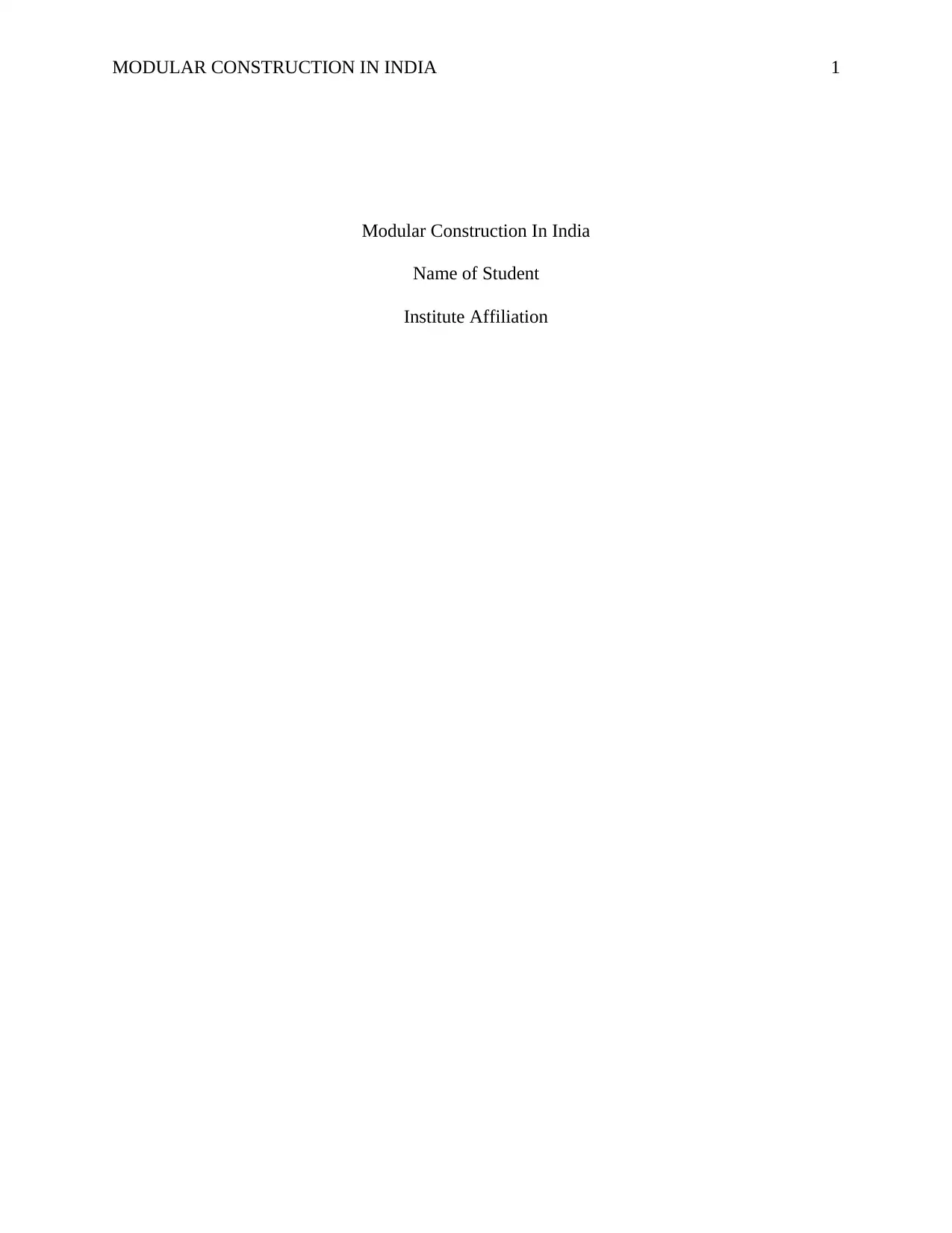
MODULAR CONSTRUCTION IN INDIA 1
Modular Construction In India
Name of Student
Institute Affiliation
Modular Construction In India
Name of Student
Institute Affiliation
Paraphrase This Document
Need a fresh take? Get an instant paraphrase of this document with our AI Paraphraser
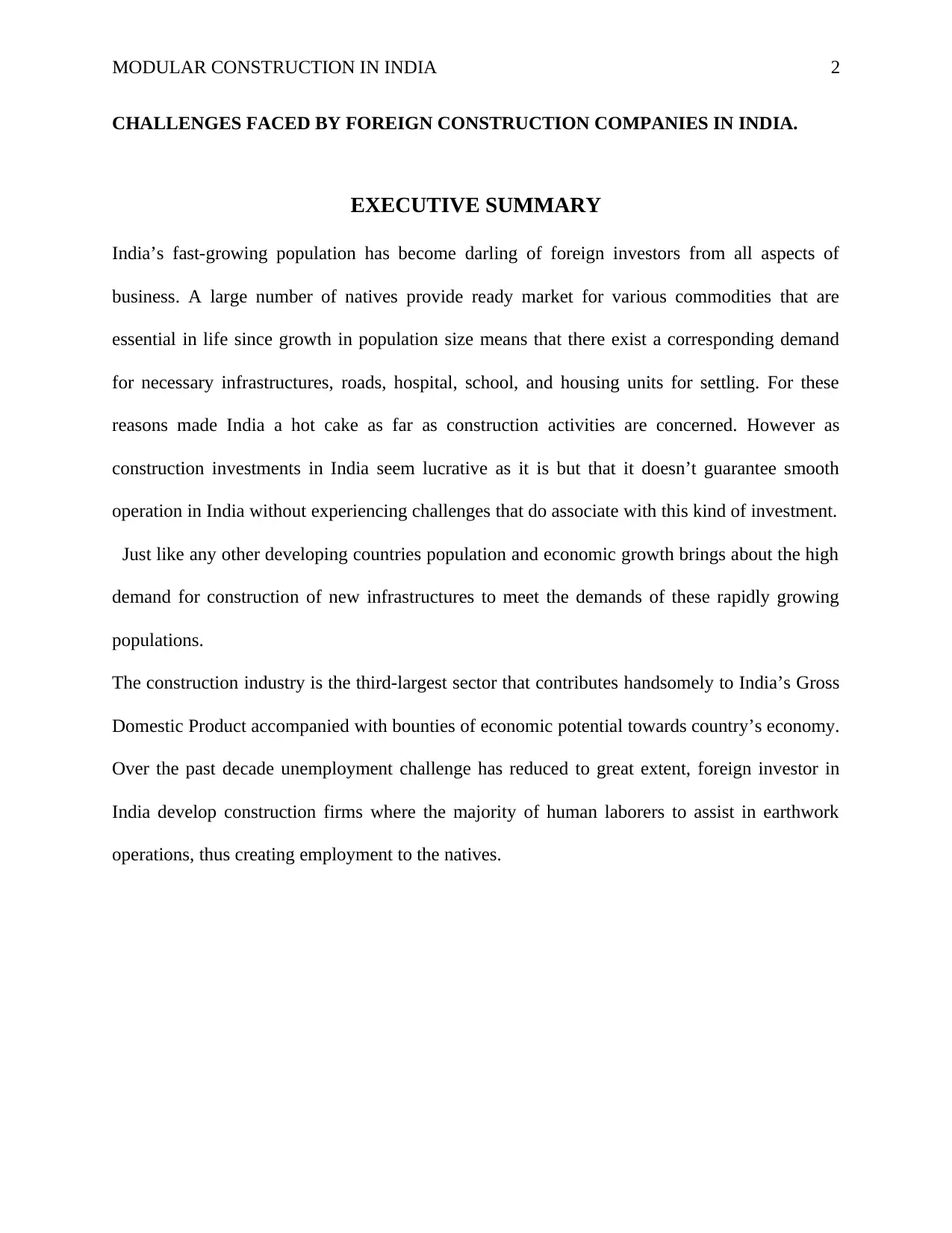
MODULAR CONSTRUCTION IN INDIA 2
CHALLENGES FACED BY FOREIGN CONSTRUCTION COMPANIES IN INDIA.
EXECUTIVE SUMMARY
India’s fast-growing population has become darling of foreign investors from all aspects of
business. A large number of natives provide ready market for various commodities that are
essential in life since growth in population size means that there exist a corresponding demand
for necessary infrastructures, roads, hospital, school, and housing units for settling. For these
reasons made India a hot cake as far as construction activities are concerned. However as
construction investments in India seem lucrative as it is but that it doesn’t guarantee smooth
operation in India without experiencing challenges that do associate with this kind of investment.
Just like any other developing countries population and economic growth brings about the high
demand for construction of new infrastructures to meet the demands of these rapidly growing
populations.
The construction industry is the third-largest sector that contributes handsomely to India’s Gross
Domestic Product accompanied with bounties of economic potential towards country’s economy.
Over the past decade unemployment challenge has reduced to great extent, foreign investor in
India develop construction firms where the majority of human laborers to assist in earthwork
operations, thus creating employment to the natives.
CHALLENGES FACED BY FOREIGN CONSTRUCTION COMPANIES IN INDIA.
EXECUTIVE SUMMARY
India’s fast-growing population has become darling of foreign investors from all aspects of
business. A large number of natives provide ready market for various commodities that are
essential in life since growth in population size means that there exist a corresponding demand
for necessary infrastructures, roads, hospital, school, and housing units for settling. For these
reasons made India a hot cake as far as construction activities are concerned. However as
construction investments in India seem lucrative as it is but that it doesn’t guarantee smooth
operation in India without experiencing challenges that do associate with this kind of investment.
Just like any other developing countries population and economic growth brings about the high
demand for construction of new infrastructures to meet the demands of these rapidly growing
populations.
The construction industry is the third-largest sector that contributes handsomely to India’s Gross
Domestic Product accompanied with bounties of economic potential towards country’s economy.
Over the past decade unemployment challenge has reduced to great extent, foreign investor in
India develop construction firms where the majority of human laborers to assist in earthwork
operations, thus creating employment to the natives.
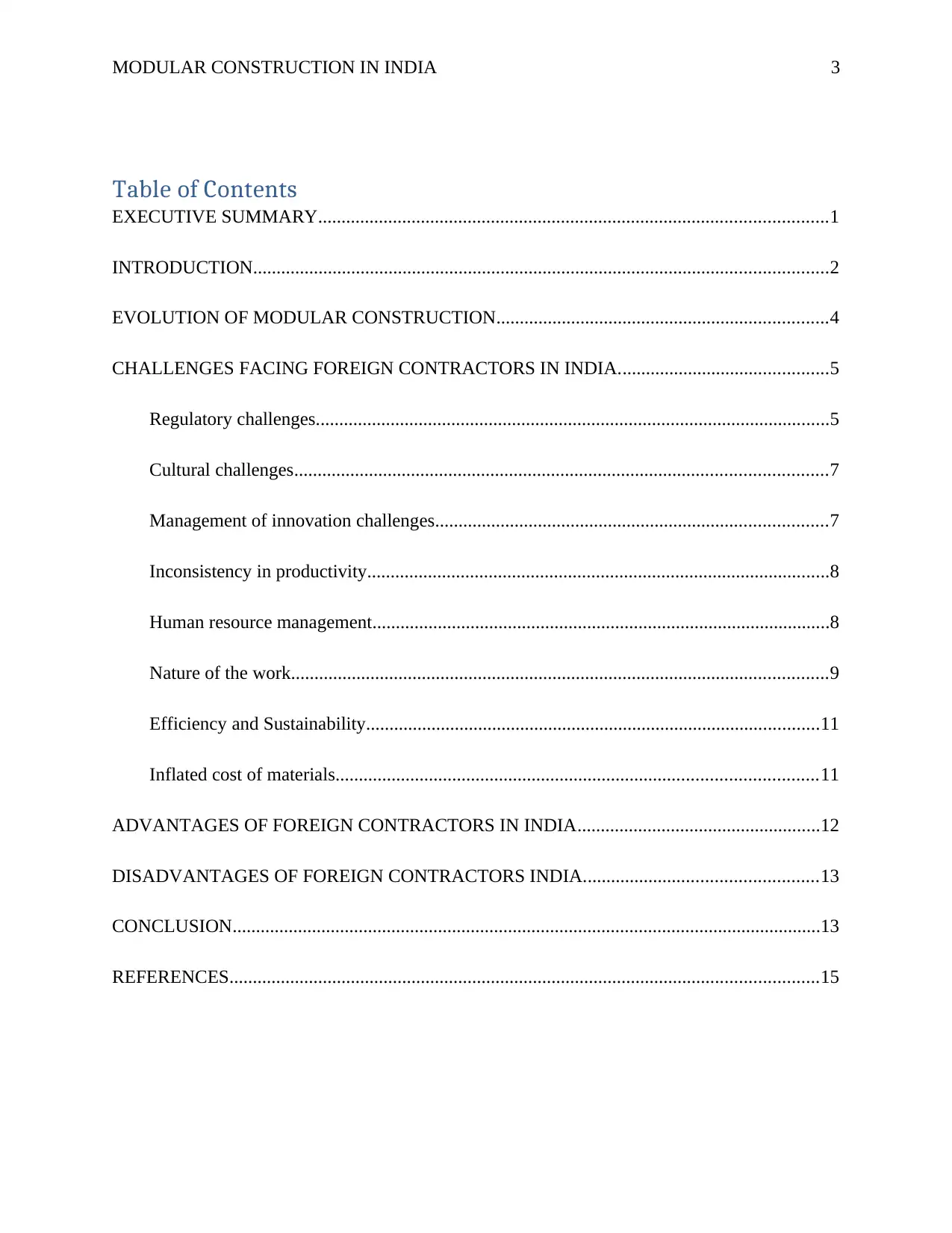
MODULAR CONSTRUCTION IN INDIA 3
Table of Contents
EXECUTIVE SUMMARY.............................................................................................................1
INTRODUCTION...........................................................................................................................2
EVOLUTION OF MODULAR CONSTRUCTION.......................................................................4
CHALLENGES FACING FOREIGN CONTRACTORS IN INDIA.............................................5
Regulatory challenges..............................................................................................................5
Cultural challenges..................................................................................................................7
Management of innovation challenges....................................................................................7
Inconsistency in productivity...................................................................................................8
Human resource management..................................................................................................8
Nature of the work...................................................................................................................9
Efficiency and Sustainability.................................................................................................11
Inflated cost of materials.......................................................................................................11
ADVANTAGES OF FOREIGN CONTRACTORS IN INDIA....................................................12
DISADVANTAGES OF FOREIGN CONTRACTORS INDIA..................................................13
CONCLUSION..............................................................................................................................13
REFERENCES..............................................................................................................................15
Table of Contents
EXECUTIVE SUMMARY.............................................................................................................1
INTRODUCTION...........................................................................................................................2
EVOLUTION OF MODULAR CONSTRUCTION.......................................................................4
CHALLENGES FACING FOREIGN CONTRACTORS IN INDIA.............................................5
Regulatory challenges..............................................................................................................5
Cultural challenges..................................................................................................................7
Management of innovation challenges....................................................................................7
Inconsistency in productivity...................................................................................................8
Human resource management..................................................................................................8
Nature of the work...................................................................................................................9
Efficiency and Sustainability.................................................................................................11
Inflated cost of materials.......................................................................................................11
ADVANTAGES OF FOREIGN CONTRACTORS IN INDIA....................................................12
DISADVANTAGES OF FOREIGN CONTRACTORS INDIA..................................................13
CONCLUSION..............................................................................................................................13
REFERENCES..............................................................................................................................15
⊘ This is a preview!⊘
Do you want full access?
Subscribe today to unlock all pages.

Trusted by 1+ million students worldwide
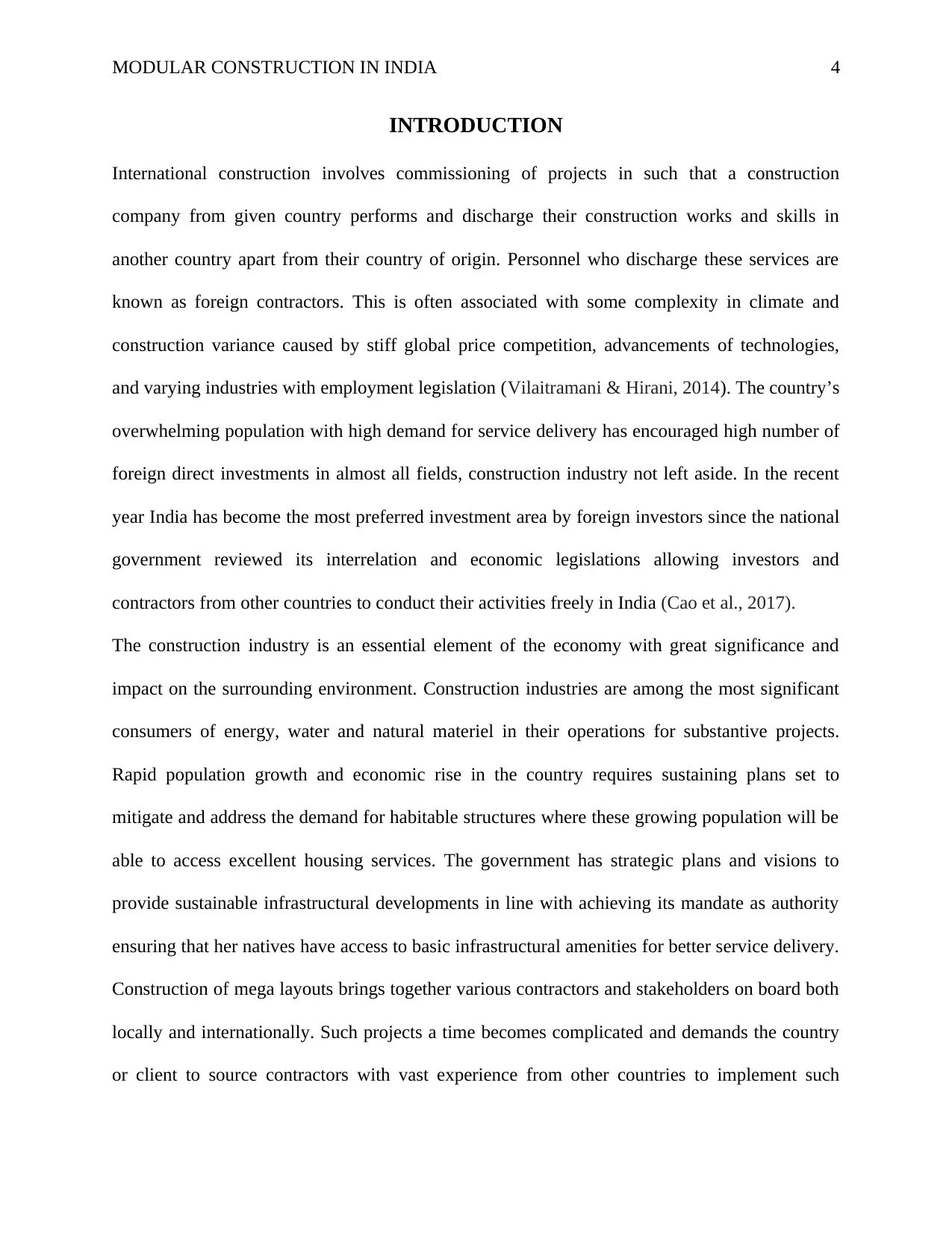
MODULAR CONSTRUCTION IN INDIA 4
INTRODUCTION
International construction involves commissioning of projects in such that a construction
company from given country performs and discharge their construction works and skills in
another country apart from their country of origin. Personnel who discharge these services are
known as foreign contractors. This is often associated with some complexity in climate and
construction variance caused by stiff global price competition, advancements of technologies,
and varying industries with employment legislation (Vilaitramani & Hirani, 2014). The country’s
overwhelming population with high demand for service delivery has encouraged high number of
foreign direct investments in almost all fields, construction industry not left aside. In the recent
year India has become the most preferred investment area by foreign investors since the national
government reviewed its interrelation and economic legislations allowing investors and
contractors from other countries to conduct their activities freely in India (Cao et al., 2017).
The construction industry is an essential element of the economy with great significance and
impact on the surrounding environment. Construction industries are among the most significant
consumers of energy, water and natural materiel in their operations for substantive projects.
Rapid population growth and economic rise in the country requires sustaining plans set to
mitigate and address the demand for habitable structures where these growing population will be
able to access excellent housing services. The government has strategic plans and visions to
provide sustainable infrastructural developments in line with achieving its mandate as authority
ensuring that her natives have access to basic infrastructural amenities for better service delivery.
Construction of mega layouts brings together various contractors and stakeholders on board both
locally and internationally. Such projects a time becomes complicated and demands the country
or client to source contractors with vast experience from other countries to implement such
INTRODUCTION
International construction involves commissioning of projects in such that a construction
company from given country performs and discharge their construction works and skills in
another country apart from their country of origin. Personnel who discharge these services are
known as foreign contractors. This is often associated with some complexity in climate and
construction variance caused by stiff global price competition, advancements of technologies,
and varying industries with employment legislation (Vilaitramani & Hirani, 2014). The country’s
overwhelming population with high demand for service delivery has encouraged high number of
foreign direct investments in almost all fields, construction industry not left aside. In the recent
year India has become the most preferred investment area by foreign investors since the national
government reviewed its interrelation and economic legislations allowing investors and
contractors from other countries to conduct their activities freely in India (Cao et al., 2017).
The construction industry is an essential element of the economy with great significance and
impact on the surrounding environment. Construction industries are among the most significant
consumers of energy, water and natural materiel in their operations for substantive projects.
Rapid population growth and economic rise in the country requires sustaining plans set to
mitigate and address the demand for habitable structures where these growing population will be
able to access excellent housing services. The government has strategic plans and visions to
provide sustainable infrastructural developments in line with achieving its mandate as authority
ensuring that her natives have access to basic infrastructural amenities for better service delivery.
Construction of mega layouts brings together various contractors and stakeholders on board both
locally and internationally. Such projects a time becomes complicated and demands the country
or client to source contractors with vast experience from other countries to implement such
Paraphrase This Document
Need a fresh take? Get an instant paraphrase of this document with our AI Paraphraser
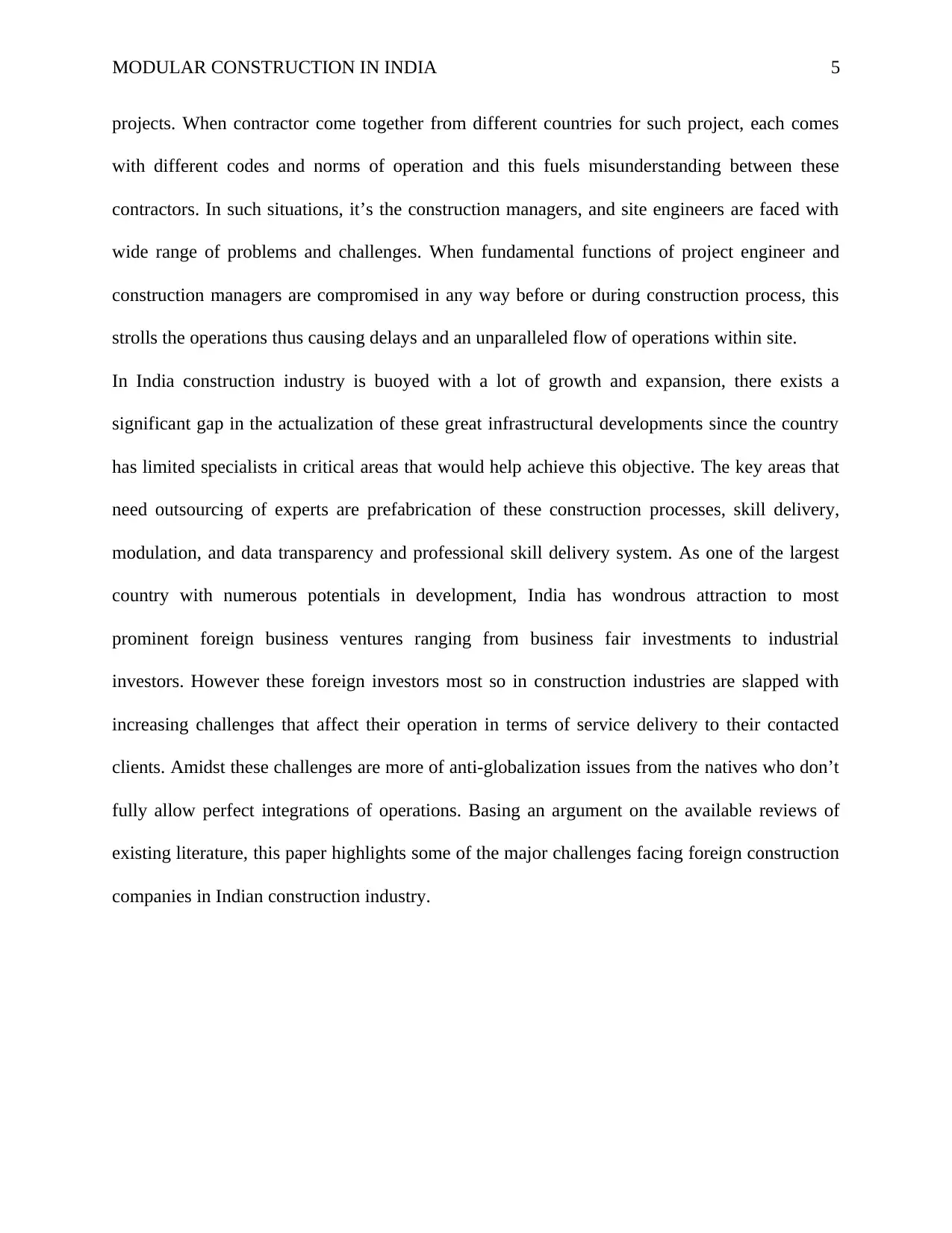
MODULAR CONSTRUCTION IN INDIA 5
projects. When contractor come together from different countries for such project, each comes
with different codes and norms of operation and this fuels misunderstanding between these
contractors. In such situations, it’s the construction managers, and site engineers are faced with
wide range of problems and challenges. When fundamental functions of project engineer and
construction managers are compromised in any way before or during construction process, this
strolls the operations thus causing delays and an unparalleled flow of operations within site.
In India construction industry is buoyed with a lot of growth and expansion, there exists a
significant gap in the actualization of these great infrastructural developments since the country
has limited specialists in critical areas that would help achieve this objective. The key areas that
need outsourcing of experts are prefabrication of these construction processes, skill delivery,
modulation, and data transparency and professional skill delivery system. As one of the largest
country with numerous potentials in development, India has wondrous attraction to most
prominent foreign business ventures ranging from business fair investments to industrial
investors. However these foreign investors most so in construction industries are slapped with
increasing challenges that affect their operation in terms of service delivery to their contacted
clients. Amidst these challenges are more of anti-globalization issues from the natives who don’t
fully allow perfect integrations of operations. Basing an argument on the available reviews of
existing literature, this paper highlights some of the major challenges facing foreign construction
companies in Indian construction industry.
projects. When contractor come together from different countries for such project, each comes
with different codes and norms of operation and this fuels misunderstanding between these
contractors. In such situations, it’s the construction managers, and site engineers are faced with
wide range of problems and challenges. When fundamental functions of project engineer and
construction managers are compromised in any way before or during construction process, this
strolls the operations thus causing delays and an unparalleled flow of operations within site.
In India construction industry is buoyed with a lot of growth and expansion, there exists a
significant gap in the actualization of these great infrastructural developments since the country
has limited specialists in critical areas that would help achieve this objective. The key areas that
need outsourcing of experts are prefabrication of these construction processes, skill delivery,
modulation, and data transparency and professional skill delivery system. As one of the largest
country with numerous potentials in development, India has wondrous attraction to most
prominent foreign business ventures ranging from business fair investments to industrial
investors. However these foreign investors most so in construction industries are slapped with
increasing challenges that affect their operation in terms of service delivery to their contacted
clients. Amidst these challenges are more of anti-globalization issues from the natives who don’t
fully allow perfect integrations of operations. Basing an argument on the available reviews of
existing literature, this paper highlights some of the major challenges facing foreign construction
companies in Indian construction industry.
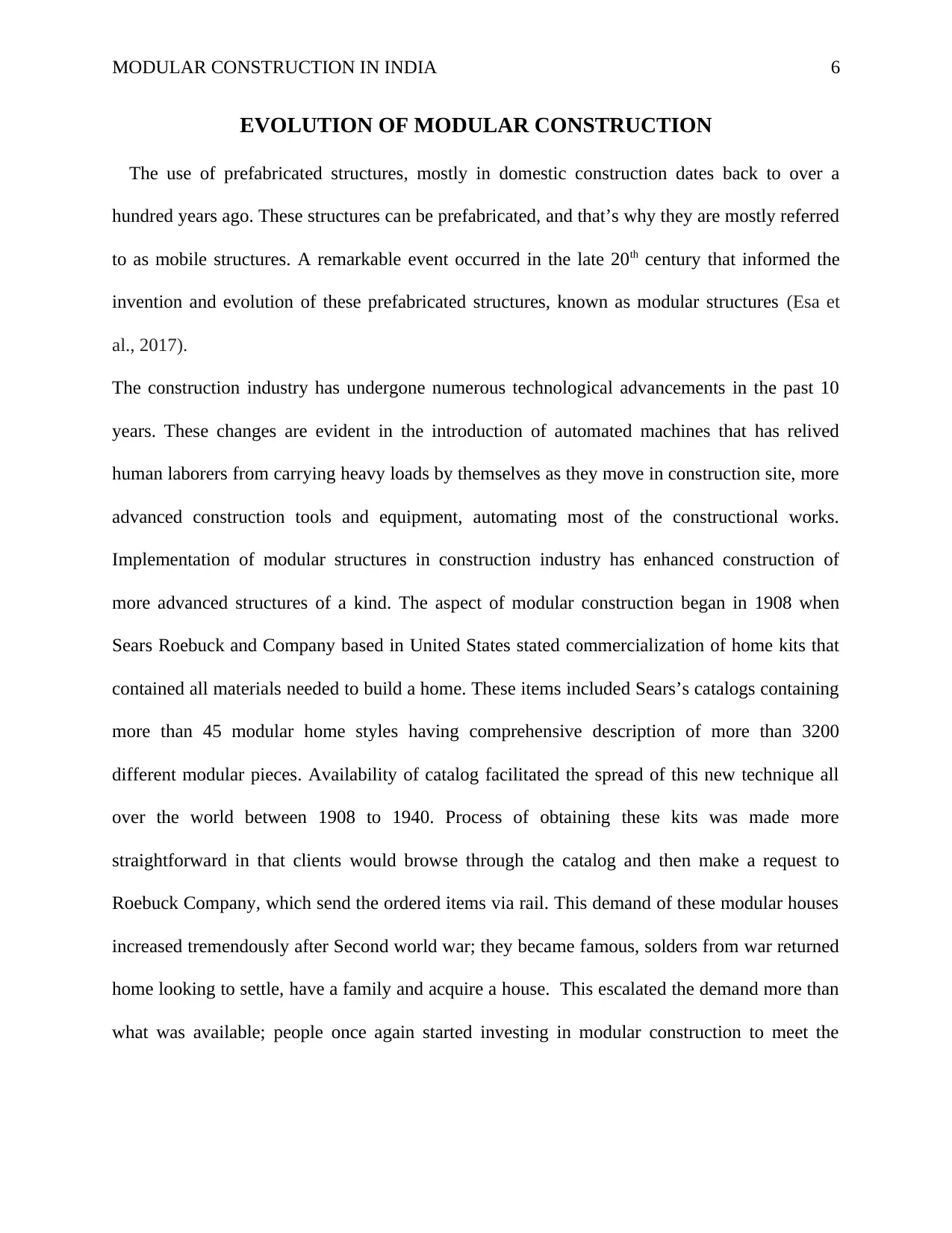
MODULAR CONSTRUCTION IN INDIA 6
EVOLUTION OF MODULAR CONSTRUCTION
The use of prefabricated structures, mostly in domestic construction dates back to over a
hundred years ago. These structures can be prefabricated, and that’s why they are mostly referred
to as mobile structures. A remarkable event occurred in the late 20th century that informed the
invention and evolution of these prefabricated structures, known as modular structures (Esa et
al., 2017).
The construction industry has undergone numerous technological advancements in the past 10
years. These changes are evident in the introduction of automated machines that has relived
human laborers from carrying heavy loads by themselves as they move in construction site, more
advanced construction tools and equipment, automating most of the constructional works.
Implementation of modular structures in construction industry has enhanced construction of
more advanced structures of a kind. The aspect of modular construction began in 1908 when
Sears Roebuck and Company based in United States stated commercialization of home kits that
contained all materials needed to build a home. These items included Sears’s catalogs containing
more than 45 modular home styles having comprehensive description of more than 3200
different modular pieces. Availability of catalog facilitated the spread of this new technique all
over the world between 1908 to 1940. Process of obtaining these kits was made more
straightforward in that clients would browse through the catalog and then make a request to
Roebuck Company, which send the ordered items via rail. This demand of these modular houses
increased tremendously after Second world war; they became famous, solders from war returned
home looking to settle, have a family and acquire a house. This escalated the demand more than
what was available; people once again started investing in modular construction to meet the
EVOLUTION OF MODULAR CONSTRUCTION
The use of prefabricated structures, mostly in domestic construction dates back to over a
hundred years ago. These structures can be prefabricated, and that’s why they are mostly referred
to as mobile structures. A remarkable event occurred in the late 20th century that informed the
invention and evolution of these prefabricated structures, known as modular structures (Esa et
al., 2017).
The construction industry has undergone numerous technological advancements in the past 10
years. These changes are evident in the introduction of automated machines that has relived
human laborers from carrying heavy loads by themselves as they move in construction site, more
advanced construction tools and equipment, automating most of the constructional works.
Implementation of modular structures in construction industry has enhanced construction of
more advanced structures of a kind. The aspect of modular construction began in 1908 when
Sears Roebuck and Company based in United States stated commercialization of home kits that
contained all materials needed to build a home. These items included Sears’s catalogs containing
more than 45 modular home styles having comprehensive description of more than 3200
different modular pieces. Availability of catalog facilitated the spread of this new technique all
over the world between 1908 to 1940. Process of obtaining these kits was made more
straightforward in that clients would browse through the catalog and then make a request to
Roebuck Company, which send the ordered items via rail. This demand of these modular houses
increased tremendously after Second world war; they became famous, solders from war returned
home looking to settle, have a family and acquire a house. This escalated the demand more than
what was available; people once again started investing in modular construction to meet the
⊘ This is a preview!⊘
Do you want full access?
Subscribe today to unlock all pages.

Trusted by 1+ million students worldwide
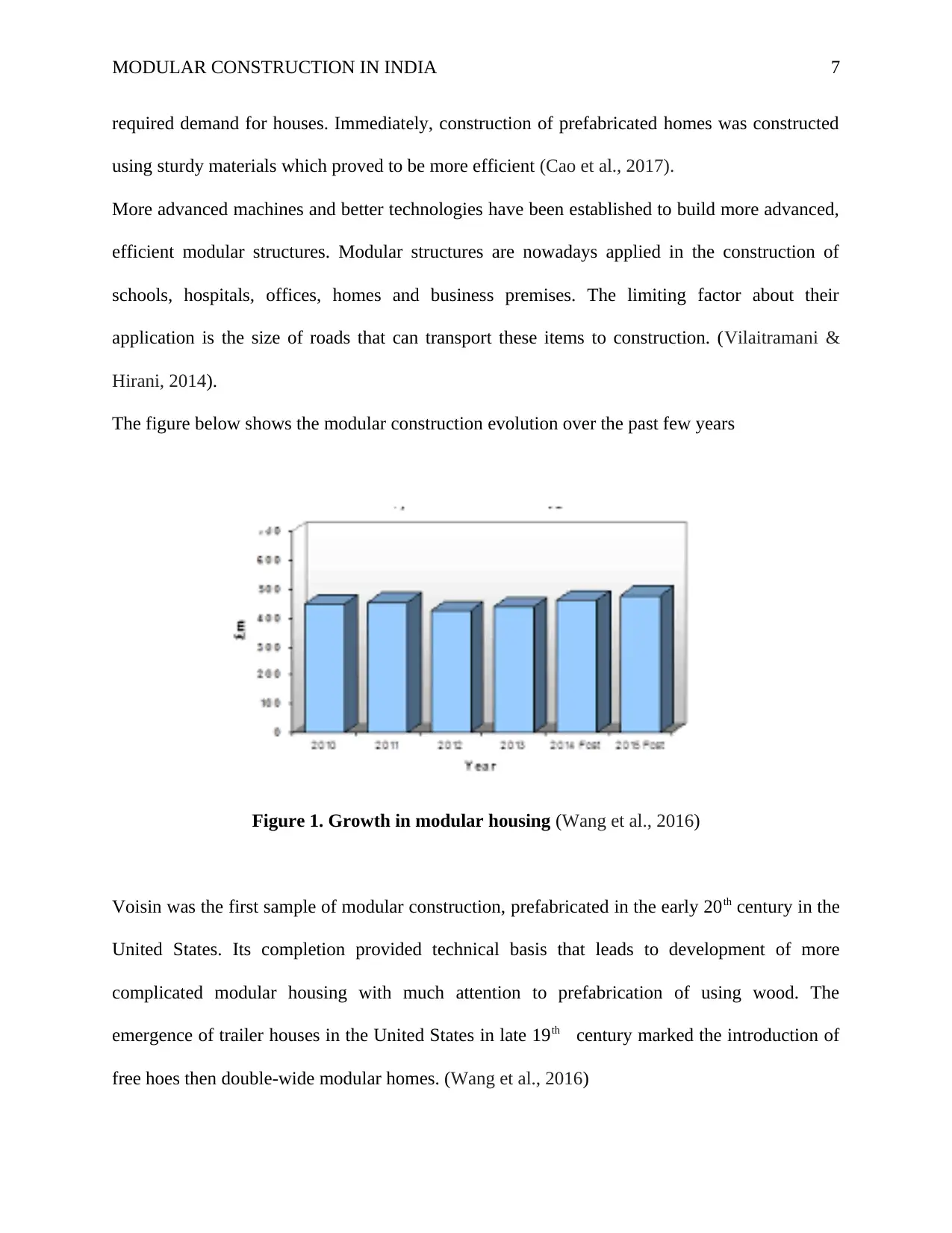
MODULAR CONSTRUCTION IN INDIA 7
required demand for houses. Immediately, construction of prefabricated homes was constructed
using sturdy materials which proved to be more efficient (Cao et al., 2017).
More advanced machines and better technologies have been established to build more advanced,
efficient modular structures. Modular structures are nowadays applied in the construction of
schools, hospitals, offices, homes and business premises. The limiting factor about their
application is the size of roads that can transport these items to construction. (Vilaitramani &
Hirani, 2014).
The figure below shows the modular construction evolution over the past few years
Figure 1. Growth in modular housing (Wang et al., 2016)
Voisin was the first sample of modular construction, prefabricated in the early 20th century in the
United States. Its completion provided technical basis that leads to development of more
complicated modular housing with much attention to prefabrication of using wood. The
emergence of trailer houses in the United States in late 19th century marked the introduction of
free hoes then double-wide modular homes. (Wang et al., 2016)
required demand for houses. Immediately, construction of prefabricated homes was constructed
using sturdy materials which proved to be more efficient (Cao et al., 2017).
More advanced machines and better technologies have been established to build more advanced,
efficient modular structures. Modular structures are nowadays applied in the construction of
schools, hospitals, offices, homes and business premises. The limiting factor about their
application is the size of roads that can transport these items to construction. (Vilaitramani &
Hirani, 2014).
The figure below shows the modular construction evolution over the past few years
Figure 1. Growth in modular housing (Wang et al., 2016)
Voisin was the first sample of modular construction, prefabricated in the early 20th century in the
United States. Its completion provided technical basis that leads to development of more
complicated modular housing with much attention to prefabrication of using wood. The
emergence of trailer houses in the United States in late 19th century marked the introduction of
free hoes then double-wide modular homes. (Wang et al., 2016)
Paraphrase This Document
Need a fresh take? Get an instant paraphrase of this document with our AI Paraphraser
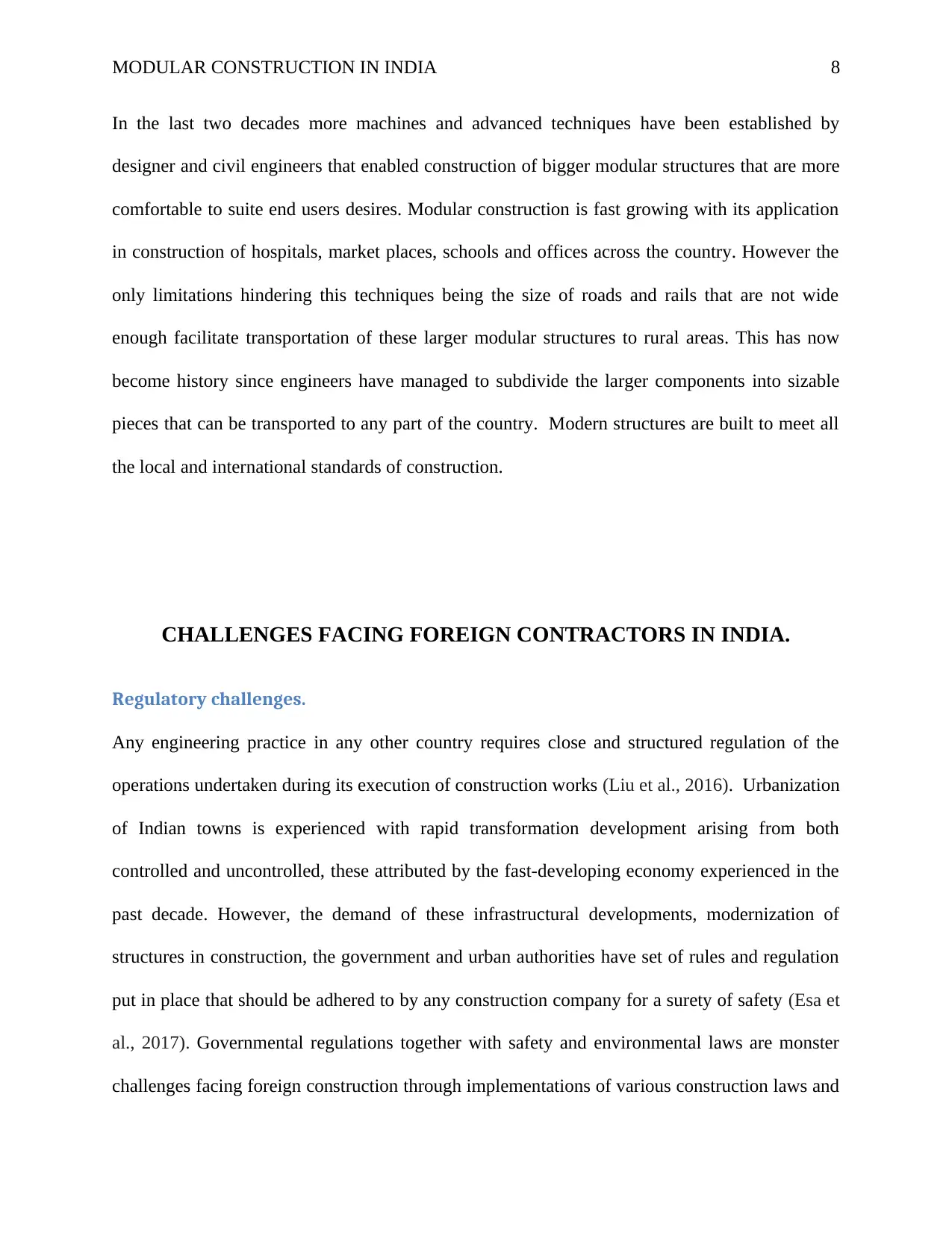
MODULAR CONSTRUCTION IN INDIA 8
In the last two decades more machines and advanced techniques have been established by
designer and civil engineers that enabled construction of bigger modular structures that are more
comfortable to suite end users desires. Modular construction is fast growing with its application
in construction of hospitals, market places, schools and offices across the country. However the
only limitations hindering this techniques being the size of roads and rails that are not wide
enough facilitate transportation of these larger modular structures to rural areas. This has now
become history since engineers have managed to subdivide the larger components into sizable
pieces that can be transported to any part of the country. Modern structures are built to meet all
the local and international standards of construction.
CHALLENGES FACING FOREIGN CONTRACTORS IN INDIA.
Regulatory challenges.
Any engineering practice in any other country requires close and structured regulation of the
operations undertaken during its execution of construction works (Liu et al., 2016). Urbanization
of Indian towns is experienced with rapid transformation development arising from both
controlled and uncontrolled, these attributed by the fast-developing economy experienced in the
past decade. However, the demand of these infrastructural developments, modernization of
structures in construction, the government and urban authorities have set of rules and regulation
put in place that should be adhered to by any construction company for a surety of safety (Esa et
al., 2017). Governmental regulations together with safety and environmental laws are monster
challenges facing foreign construction through implementations of various construction laws and
In the last two decades more machines and advanced techniques have been established by
designer and civil engineers that enabled construction of bigger modular structures that are more
comfortable to suite end users desires. Modular construction is fast growing with its application
in construction of hospitals, market places, schools and offices across the country. However the
only limitations hindering this techniques being the size of roads and rails that are not wide
enough facilitate transportation of these larger modular structures to rural areas. This has now
become history since engineers have managed to subdivide the larger components into sizable
pieces that can be transported to any part of the country. Modern structures are built to meet all
the local and international standards of construction.
CHALLENGES FACING FOREIGN CONTRACTORS IN INDIA.
Regulatory challenges.
Any engineering practice in any other country requires close and structured regulation of the
operations undertaken during its execution of construction works (Liu et al., 2016). Urbanization
of Indian towns is experienced with rapid transformation development arising from both
controlled and uncontrolled, these attributed by the fast-developing economy experienced in the
past decade. However, the demand of these infrastructural developments, modernization of
structures in construction, the government and urban authorities have set of rules and regulation
put in place that should be adhered to by any construction company for a surety of safety (Esa et
al., 2017). Governmental regulations together with safety and environmental laws are monster
challenges facing foreign construction through implementations of various construction laws and
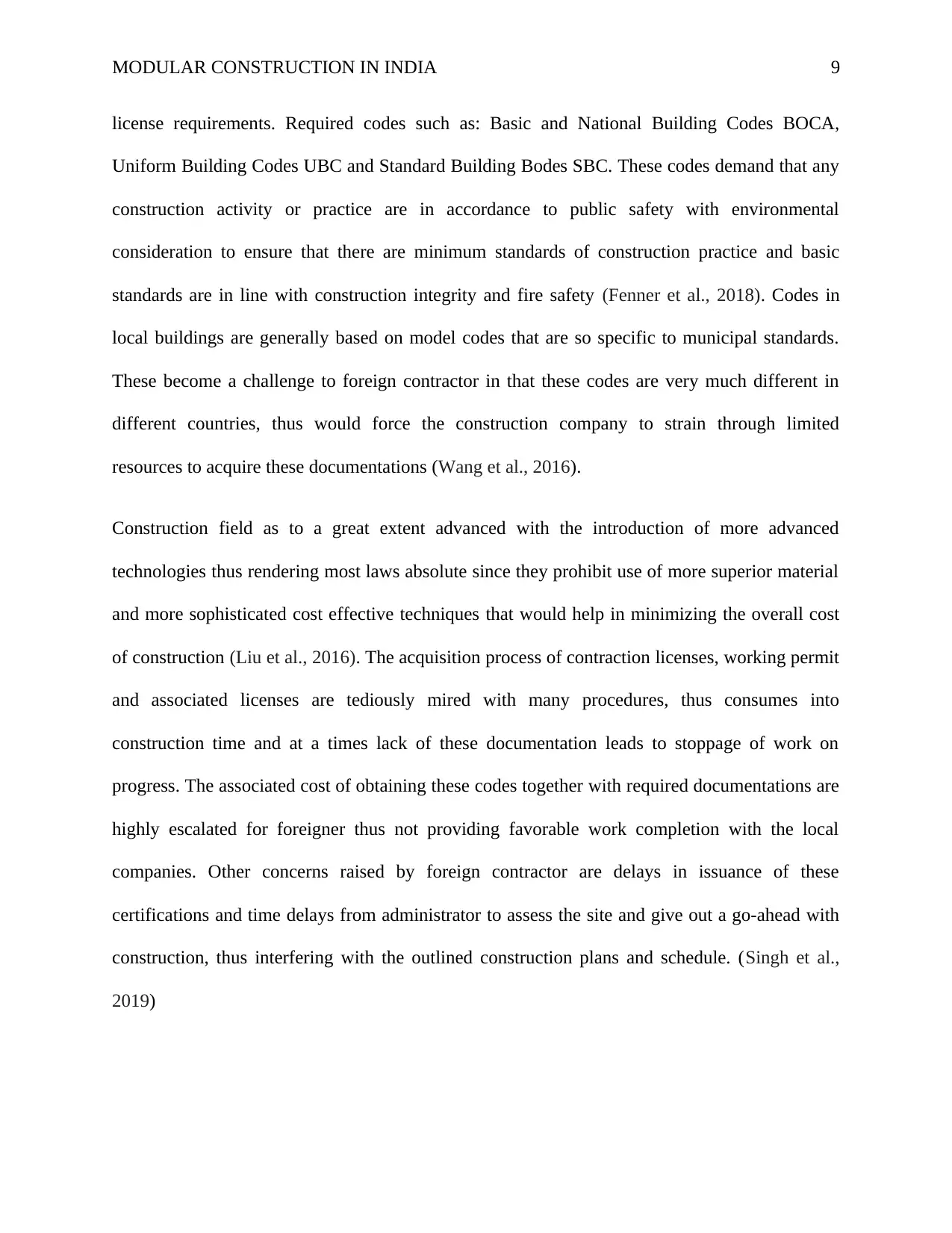
MODULAR CONSTRUCTION IN INDIA 9
license requirements. Required codes such as: Basic and National Building Codes BOCA,
Uniform Building Codes UBC and Standard Building Bodes SBC. These codes demand that any
construction activity or practice are in accordance to public safety with environmental
consideration to ensure that there are minimum standards of construction practice and basic
standards are in line with construction integrity and fire safety (Fenner et al., 2018). Codes in
local buildings are generally based on model codes that are so specific to municipal standards.
These become a challenge to foreign contractor in that these codes are very much different in
different countries, thus would force the construction company to strain through limited
resources to acquire these documentations (Wang et al., 2016).
Construction field as to a great extent advanced with the introduction of more advanced
technologies thus rendering most laws absolute since they prohibit use of more superior material
and more sophisticated cost effective techniques that would help in minimizing the overall cost
of construction (Liu et al., 2016). The acquisition process of contraction licenses, working permit
and associated licenses are tediously mired with many procedures, thus consumes into
construction time and at a times lack of these documentation leads to stoppage of work on
progress. The associated cost of obtaining these codes together with required documentations are
highly escalated for foreigner thus not providing favorable work completion with the local
companies. Other concerns raised by foreign contractor are delays in issuance of these
certifications and time delays from administrator to assess the site and give out a go-ahead with
construction, thus interfering with the outlined construction plans and schedule. (Singh et al.,
2019)
license requirements. Required codes such as: Basic and National Building Codes BOCA,
Uniform Building Codes UBC and Standard Building Bodes SBC. These codes demand that any
construction activity or practice are in accordance to public safety with environmental
consideration to ensure that there are minimum standards of construction practice and basic
standards are in line with construction integrity and fire safety (Fenner et al., 2018). Codes in
local buildings are generally based on model codes that are so specific to municipal standards.
These become a challenge to foreign contractor in that these codes are very much different in
different countries, thus would force the construction company to strain through limited
resources to acquire these documentations (Wang et al., 2016).
Construction field as to a great extent advanced with the introduction of more advanced
technologies thus rendering most laws absolute since they prohibit use of more superior material
and more sophisticated cost effective techniques that would help in minimizing the overall cost
of construction (Liu et al., 2016). The acquisition process of contraction licenses, working permit
and associated licenses are tediously mired with many procedures, thus consumes into
construction time and at a times lack of these documentation leads to stoppage of work on
progress. The associated cost of obtaining these codes together with required documentations are
highly escalated for foreigner thus not providing favorable work completion with the local
companies. Other concerns raised by foreign contractor are delays in issuance of these
certifications and time delays from administrator to assess the site and give out a go-ahead with
construction, thus interfering with the outlined construction plans and schedule. (Singh et al.,
2019)
⊘ This is a preview!⊘
Do you want full access?
Subscribe today to unlock all pages.

Trusted by 1+ million students worldwide
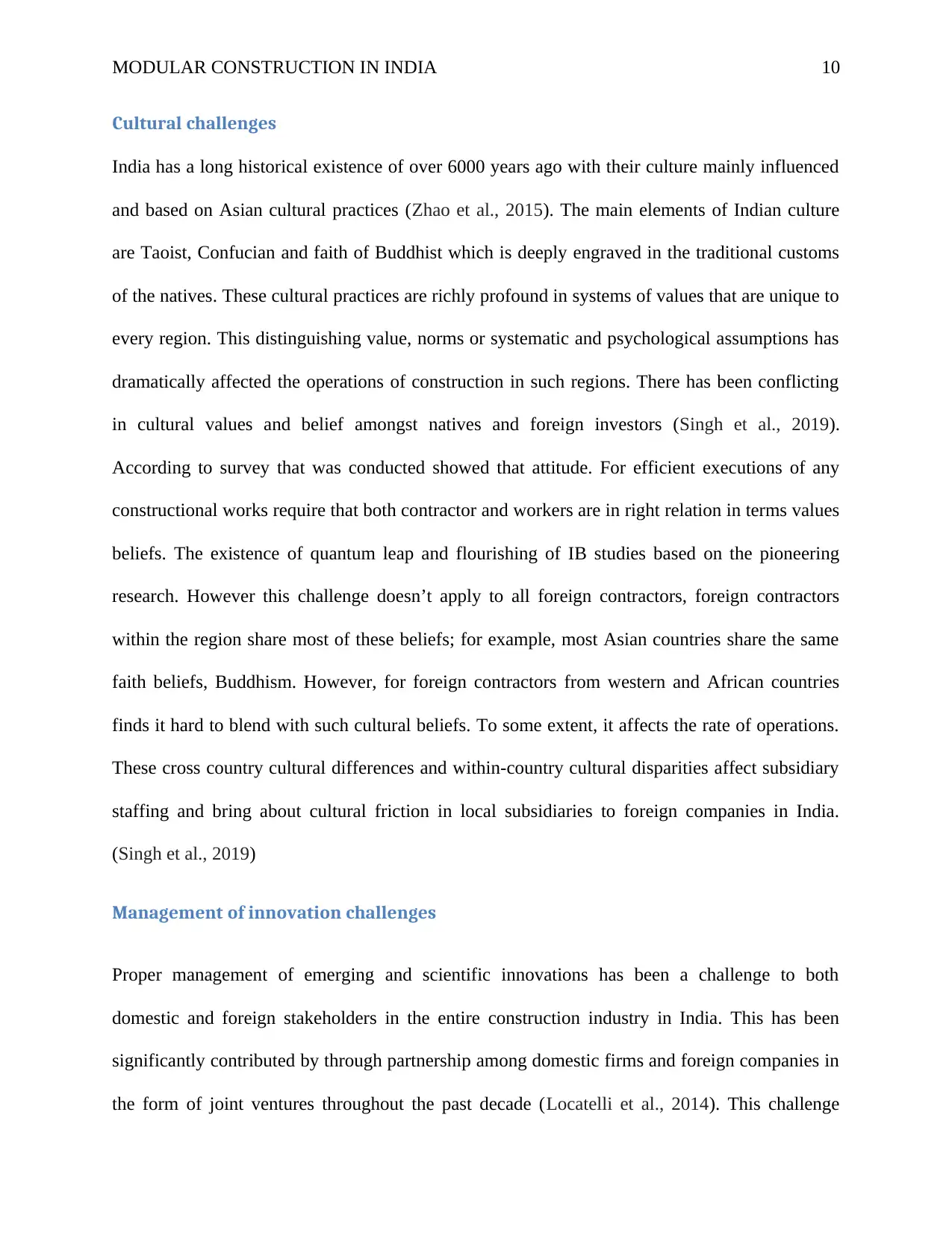
MODULAR CONSTRUCTION IN INDIA 10
Cultural challenges
India has a long historical existence of over 6000 years ago with their culture mainly influenced
and based on Asian cultural practices (Zhao et al., 2015). The main elements of Indian culture
are Taoist, Confucian and faith of Buddhist which is deeply engraved in the traditional customs
of the natives. These cultural practices are richly profound in systems of values that are unique to
every region. This distinguishing value, norms or systematic and psychological assumptions has
dramatically affected the operations of construction in such regions. There has been conflicting
in cultural values and belief amongst natives and foreign investors (Singh et al., 2019).
According to survey that was conducted showed that attitude. For efficient executions of any
constructional works require that both contractor and workers are in right relation in terms values
beliefs. The existence of quantum leap and flourishing of IB studies based on the pioneering
research. However this challenge doesn’t apply to all foreign contractors, foreign contractors
within the region share most of these beliefs; for example, most Asian countries share the same
faith beliefs, Buddhism. However, for foreign contractors from western and African countries
finds it hard to blend with such cultural beliefs. To some extent, it affects the rate of operations.
These cross country cultural differences and within-country cultural disparities affect subsidiary
staffing and bring about cultural friction in local subsidiaries to foreign companies in India.
(Singh et al., 2019)
Management of innovation challenges
Proper management of emerging and scientific innovations has been a challenge to both
domestic and foreign stakeholders in the entire construction industry in India. This has been
significantly contributed by through partnership among domestic firms and foreign companies in
the form of joint ventures throughout the past decade (Locatelli et al., 2014). This challenge
Cultural challenges
India has a long historical existence of over 6000 years ago with their culture mainly influenced
and based on Asian cultural practices (Zhao et al., 2015). The main elements of Indian culture
are Taoist, Confucian and faith of Buddhist which is deeply engraved in the traditional customs
of the natives. These cultural practices are richly profound in systems of values that are unique to
every region. This distinguishing value, norms or systematic and psychological assumptions has
dramatically affected the operations of construction in such regions. There has been conflicting
in cultural values and belief amongst natives and foreign investors (Singh et al., 2019).
According to survey that was conducted showed that attitude. For efficient executions of any
constructional works require that both contractor and workers are in right relation in terms values
beliefs. The existence of quantum leap and flourishing of IB studies based on the pioneering
research. However this challenge doesn’t apply to all foreign contractors, foreign contractors
within the region share most of these beliefs; for example, most Asian countries share the same
faith beliefs, Buddhism. However, for foreign contractors from western and African countries
finds it hard to blend with such cultural beliefs. To some extent, it affects the rate of operations.
These cross country cultural differences and within-country cultural disparities affect subsidiary
staffing and bring about cultural friction in local subsidiaries to foreign companies in India.
(Singh et al., 2019)
Management of innovation challenges
Proper management of emerging and scientific innovations has been a challenge to both
domestic and foreign stakeholders in the entire construction industry in India. This has been
significantly contributed by through partnership among domestic firms and foreign companies in
the form of joint ventures throughout the past decade (Locatelli et al., 2014). This challenge
Paraphrase This Document
Need a fresh take? Get an instant paraphrase of this document with our AI Paraphraser
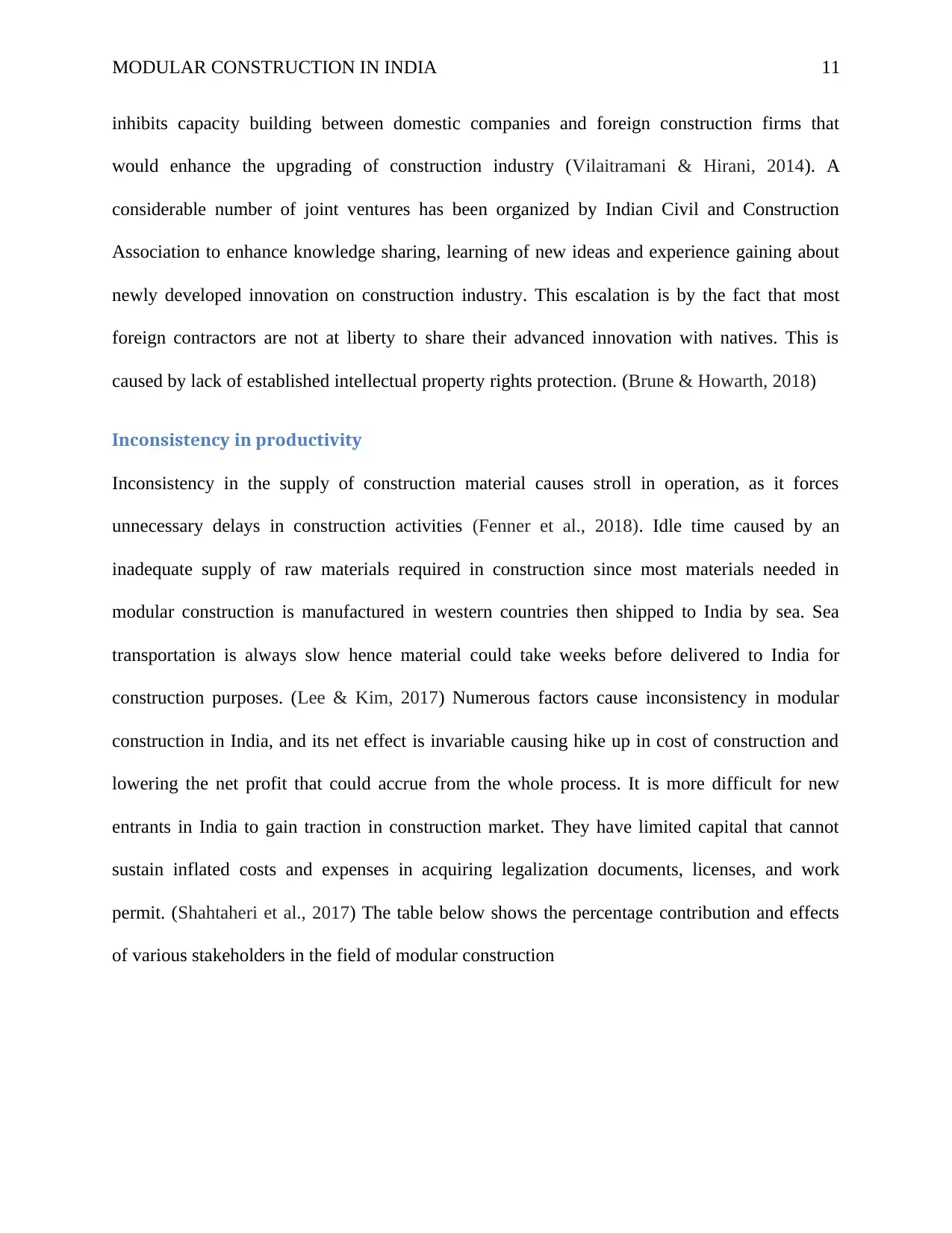
MODULAR CONSTRUCTION IN INDIA 11
inhibits capacity building between domestic companies and foreign construction firms that
would enhance the upgrading of construction industry (Vilaitramani & Hirani, 2014). A
considerable number of joint ventures has been organized by Indian Civil and Construction
Association to enhance knowledge sharing, learning of new ideas and experience gaining about
newly developed innovation on construction industry. This escalation is by the fact that most
foreign contractors are not at liberty to share their advanced innovation with natives. This is
caused by lack of established intellectual property rights protection. (Brune & Howarth, 2018)
Inconsistency in productivity
Inconsistency in the supply of construction material causes stroll in operation, as it forces
unnecessary delays in construction activities (Fenner et al., 2018). Idle time caused by an
inadequate supply of raw materials required in construction since most materials needed in
modular construction is manufactured in western countries then shipped to India by sea. Sea
transportation is always slow hence material could take weeks before delivered to India for
construction purposes. (Lee & Kim, 2017) Numerous factors cause inconsistency in modular
construction in India, and its net effect is invariable causing hike up in cost of construction and
lowering the net profit that could accrue from the whole process. It is more difficult for new
entrants in India to gain traction in construction market. They have limited capital that cannot
sustain inflated costs and expenses in acquiring legalization documents, licenses, and work
permit. (Shahtaheri et al., 2017) The table below shows the percentage contribution and effects
of various stakeholders in the field of modular construction
inhibits capacity building between domestic companies and foreign construction firms that
would enhance the upgrading of construction industry (Vilaitramani & Hirani, 2014). A
considerable number of joint ventures has been organized by Indian Civil and Construction
Association to enhance knowledge sharing, learning of new ideas and experience gaining about
newly developed innovation on construction industry. This escalation is by the fact that most
foreign contractors are not at liberty to share their advanced innovation with natives. This is
caused by lack of established intellectual property rights protection. (Brune & Howarth, 2018)
Inconsistency in productivity
Inconsistency in the supply of construction material causes stroll in operation, as it forces
unnecessary delays in construction activities (Fenner et al., 2018). Idle time caused by an
inadequate supply of raw materials required in construction since most materials needed in
modular construction is manufactured in western countries then shipped to India by sea. Sea
transportation is always slow hence material could take weeks before delivered to India for
construction purposes. (Lee & Kim, 2017) Numerous factors cause inconsistency in modular
construction in India, and its net effect is invariable causing hike up in cost of construction and
lowering the net profit that could accrue from the whole process. It is more difficult for new
entrants in India to gain traction in construction market. They have limited capital that cannot
sustain inflated costs and expenses in acquiring legalization documents, licenses, and work
permit. (Shahtaheri et al., 2017) The table below shows the percentage contribution and effects
of various stakeholders in the field of modular construction
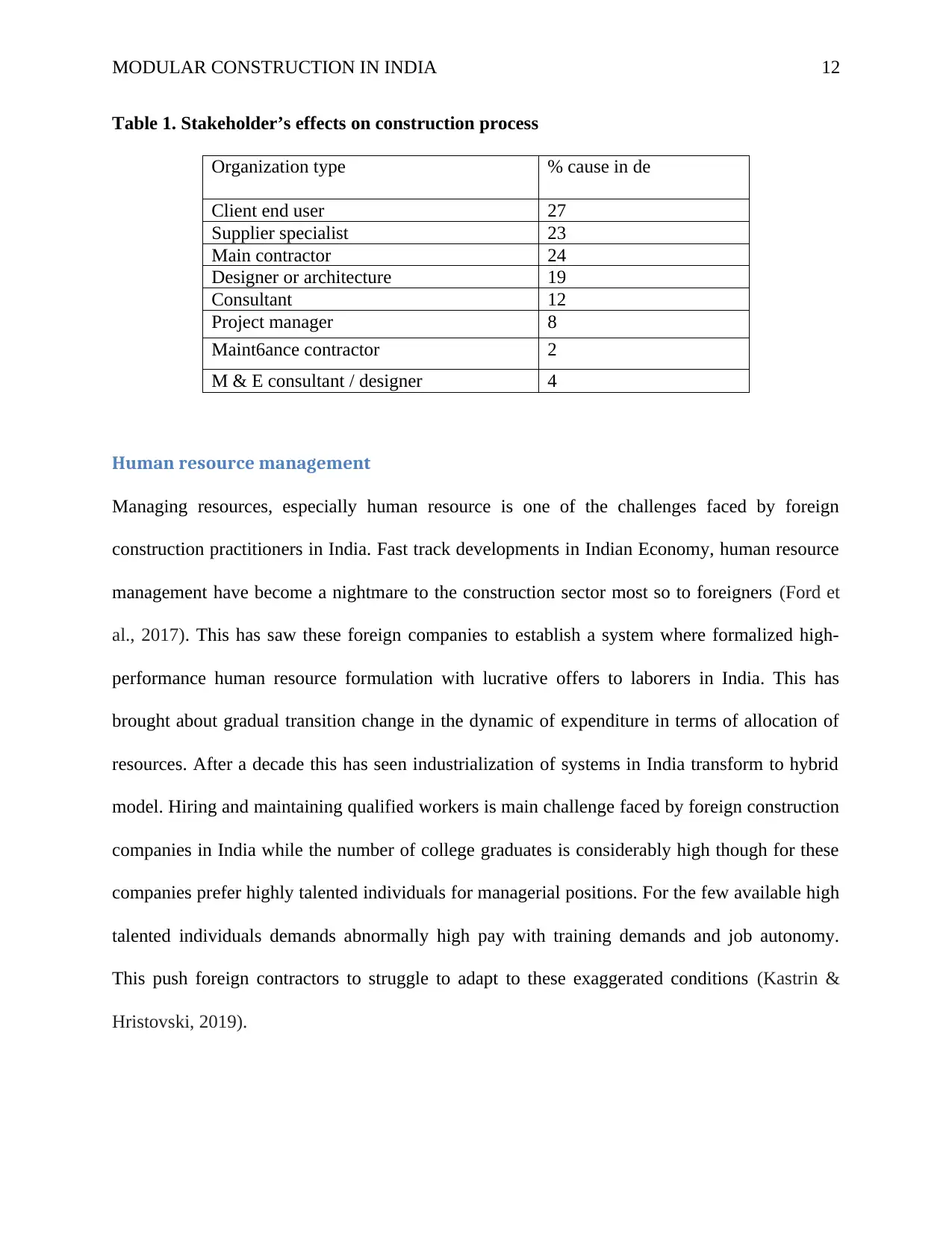
MODULAR CONSTRUCTION IN INDIA 12
Table 1. Stakeholder’s effects on construction process
Organization type % cause in de
Client end user 27
Supplier specialist 23
Main contractor 24
Designer or architecture 19
Consultant 12
Project manager 8
Maint6ance contractor 2
M & E consultant / designer 4
Human resource management
Managing resources, especially human resource is one of the challenges faced by foreign
construction practitioners in India. Fast track developments in Indian Economy, human resource
management have become a nightmare to the construction sector most so to foreigners (Ford et
al., 2017). This has saw these foreign companies to establish a system where formalized high-
performance human resource formulation with lucrative offers to laborers in India. This has
brought about gradual transition change in the dynamic of expenditure in terms of allocation of
resources. After a decade this has seen industrialization of systems in India transform to hybrid
model. Hiring and maintaining qualified workers is main challenge faced by foreign construction
companies in India while the number of college graduates is considerably high though for these
companies prefer highly talented individuals for managerial positions. For the few available high
talented individuals demands abnormally high pay with training demands and job autonomy.
This push foreign contractors to struggle to adapt to these exaggerated conditions (Kastrin &
Hristovski, 2019).
Table 1. Stakeholder’s effects on construction process
Organization type % cause in de
Client end user 27
Supplier specialist 23
Main contractor 24
Designer or architecture 19
Consultant 12
Project manager 8
Maint6ance contractor 2
M & E consultant / designer 4
Human resource management
Managing resources, especially human resource is one of the challenges faced by foreign
construction practitioners in India. Fast track developments in Indian Economy, human resource
management have become a nightmare to the construction sector most so to foreigners (Ford et
al., 2017). This has saw these foreign companies to establish a system where formalized high-
performance human resource formulation with lucrative offers to laborers in India. This has
brought about gradual transition change in the dynamic of expenditure in terms of allocation of
resources. After a decade this has seen industrialization of systems in India transform to hybrid
model. Hiring and maintaining qualified workers is main challenge faced by foreign construction
companies in India while the number of college graduates is considerably high though for these
companies prefer highly talented individuals for managerial positions. For the few available high
talented individuals demands abnormally high pay with training demands and job autonomy.
This push foreign contractors to struggle to adapt to these exaggerated conditions (Kastrin &
Hristovski, 2019).
⊘ This is a preview!⊘
Do you want full access?
Subscribe today to unlock all pages.

Trusted by 1+ million students worldwide
1 out of 24
Related Documents
Your All-in-One AI-Powered Toolkit for Academic Success.
+13062052269
info@desklib.com
Available 24*7 on WhatsApp / Email
![[object Object]](/_next/static/media/star-bottom.7253800d.svg)
Unlock your academic potential
Copyright © 2020–2025 A2Z Services. All Rights Reserved. Developed and managed by ZUCOL.





